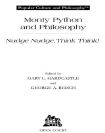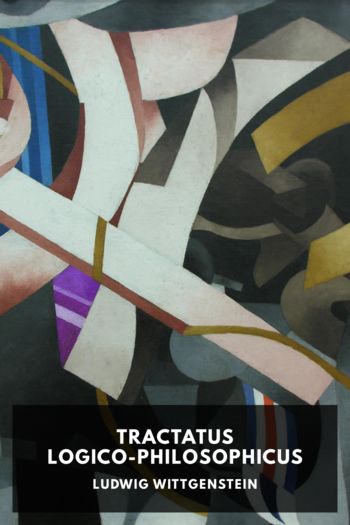Monty Python and Philosophy, Gary Hardcastle [portable ebook reader TXT] 📗

- Author: Gary Hardcastle
Book online «Monty Python and Philosophy, Gary Hardcastle [portable ebook reader TXT] 📗». Author Gary Hardcastle
Now let us consider the physical world in general. The universe is chock full of orderly phenomena, as Eric Idle observes in “The Galaxy Song” from Monty Python’s The Meaning of Life:
Just remember that you’re standing on a planet that’s evolving
And revolving at nine hundred miles an hour.
That’s orbiting at nineteen miles a second, so it’s reckoned,
A sun that is the source of all our power.
The sun and you and me, and all the stars that we can see,
Are moving at a million miles a day,
In the outer spiral arm, at forty thousand miles an hour,
of the galaxy we call the Milky Way . . .
The physical version of the Argument from Design states that all of this astronomical order and law-governed motion cannot have arisen due to chance, and therefore must have as its source a Higher Intelligence.
Today it is widely acknowledged throughout the world (and much of the United States) that Darwin’s discovery of evolution by natural selection blew away the biological version of the Argument from Design. As the Pythons acknowledge in the title track to Monty Python’s The Meaning of Life, “scientists say we’re just spiraling coils/ Of self-replicating DNA.” Blind variation in physical traits, some traits faring better than others in the struggle for existence, the encoding of traits in DNA, and their inheritance by offspring provide the basic ingredients for the evolution of adaptation by natural selection. A Divine Designer is not necessary to explain the presence of biological adaptations. Yet the physical version of the Argument from Design refuses to die. Many scientists and engineers today, while acknowledging that Darwin’s discovery of evolution by natural selection has undercut the biological version of the argument, argue that the physical version of the Design Argument receives stronger and stronger support with each new theoretical advance in our understanding of the universe. Newton certainly thought so, as did Einstein, who wrote in The World As I See It (1934), pp. 267-68:
Religious feeling takes the form of a rapturous amazement at the harmony of natural law, which reveals an intelligence of such superiority that, compared with it, all the systematic thinking and acting of human beings is utterly insignificant reflection.
This quotation emphasizes another dimension to the Argument from Design. Not only does the universe afford us evidence of the existence of God, but of His attributes as well. God possesses an intelligence that in some vague way is like human intelligence, only more super. Hume, a big Newton fan, and himself very much impressed with the orderliness of the universe, was very dismissive of this argument. For one thing, to invoke a Divine Intelligence to explain the origin of order in the universe doesn’t seem to explain anything at all. It simply takes one mystery, the presence of order in the universe, and replaces it with something equally mysterious, a Divine Intelligence (in Hume’s words, an “intelligent agent”). We might just as well ask where Divine Intelligence comes from. Clearly, Hume argues, this explanation gives no satisfaction. Yet even granting that the universe has a Creator, Hume was skeptical of the prospects of inferring His attributes from His creation. Where the orthodox Christian believer saw in nature evidence of God’s moral righteousness, benevolence, and omnipotence, Hume saw evidence of moral indifference. Monty Python captured Hume’s critique brilliantly on their Contractual Obligation Album in their mock hymn, “All Things Dull and Ugly”:
All things dull and ugly,
All creatures short and squat,
All things rude and nasty,
The Lord God made the lot.
Each little snake that poisons,
Each little wasp that stings.
He made their brutish venom,
He made their horrid wings.
All things sick and cancerous,
All evil great and small,
All things foul and dangerous,
The Lord God made them all.
Each nasty little hornet,
Each beastly little squid.
Who made the spiky urchin?
Who made the sharks? He did.
All things scabbed and ulcerous,
All pox both great and small.
Putrid, foul, and gangrenous,
The Lord God made them all.
Hume believed that the Argument from Design did not derive its persuasiveness from observations of the imperfect world around us, but rather from weakly veiled appeals to church doctrine, which preached the existence of a single, all-powerful, eternal, and benevolent God. Our observations of the world are influenced by our prior beliefs about God. In other words, when we look out at the world, we aren’t seeing evidence of God’s attributes in the world, rather, we are simply seeing the world through God-colored glasses, selectively ignoring all things dull, ugly, rude, and nasty. Hume thought that not very much about God can be inferred from his creation. To underscore his point, he ventured a number of hypotheses equally compatible with the observations. Perhaps, he mused, the universe is the work of many Gods. Or maybe it was initiated by a deity who has long since abandoned it to its own devices.
There is a scene in Terry Gilliam’s opening animation sequence to Monty Python’s The Meaning of Life where God is shown vacillating between two possible earths, one spherical and the other cubical. Opting for the spherical one, he tosses it off to one side whereupon it promptly cracks open. Hume had invoked a similar image in Dialogues Concerning Natural Religion to emphasize that a number





Comments (0)